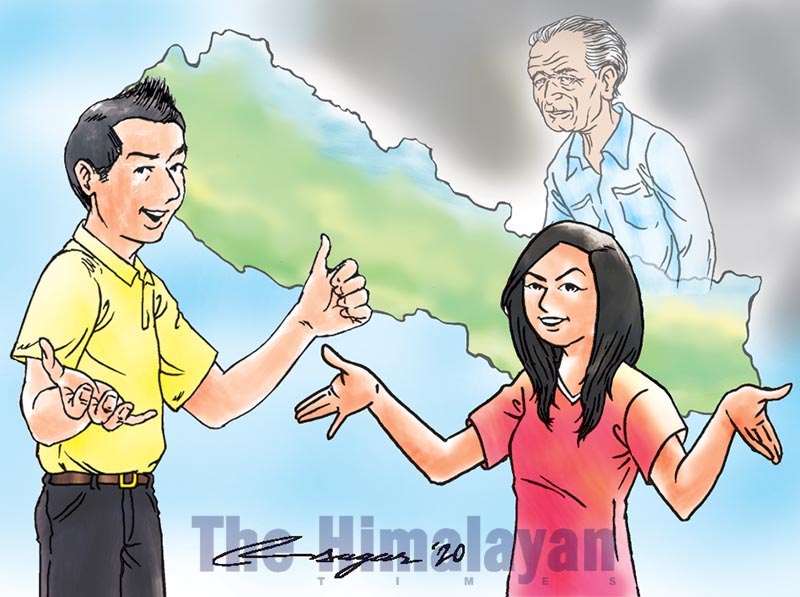Demographic dividend: Let’s reap before it rots
Nepal will become an ageing society around 2028, and an aged society around 2054, in another 34 years. This speed of ageing is very fast, and more or less the same as that of advanced Japan
The 3Ds- demand, democracy and demographic dividend - are the key factors in the economic development of a nation. Demographic dividend, also known as ‘population bonus’, occurs when the number of working age people is higher than the number of dependents (elderly and children). The ratio of the elderly and children to the working age population is known as the dependency ratio. A low dependency ratio means potentially more people can be productive and contribute to the growth of the economy.
Nepal has been experiencing very rapid demographic changes in the last few decades as it transits from a high-mortality, high-fertility society to a low-mortality, low-fertility society within a relatively short span of time. This changeover is an extremely positive outcome of the country’s development. But with it, there are two major challenges that the country needs to quickly prepare for, that is, rapid progress of the ‘ageing’ of the society and the duration of the ‘demographic window of opportunity’ period. According to National Planning Commission (NPC), as of 2015, 11.1 of the working-age people (15-64 years) have been supporting one old-age person in Nepal. By 2050, 5.6 working-age people will need to support one old-age person, which is half of today’s ratio. By 2060, this ratio becomes 3.8 working-age people per old-age person, one-third of today’s ratio in another 40 years counting from 2020. This will only be possible if children today and subsequent generations to come are raised to become far more productive than today’s adults. This, in turn, necessitates prioritised investments in children today for their healthy and sound growth, both physically and mentally.
In areas where the dependency ratio is in the middle range, priority should be on improving the human capital by investing in youth’s education, while where the dependency ratio is sufficiently low, priority should be to ensure the population remains productive by providing better access to employment, either through an active labour market policy or by raising investment in new jobs. The demographic window of opportunity is a period of time in a nation’s demographic evolution when the proportion of the working-age population is particularly prominent. Countries that put the right policies in place and necessary investments to back them have been able to effectively take advantage of this opportunity and reap demographic dividends in the form of accelerated human development and economic growth.
An ageing society is defined as one where the percentage of people aged 65 years and older, or old-age dependents, accounts for 7 per cent or more of the total population. When this ratio doubles, the concerned society is called an “aged society.” Nepal will become an ageing society around 2028, and an aged society around 2054, in another 34 years. This speed of ageing is very fast, and more or less the same as that of advanced Japan, which went through the same transition process in just 24 years between 1970 and 1994.
Moreover, one way to measure the duration of this demographic window of opportunity is to calculate the number of years between the time when the percentage of the working-age population (15-64 years) vis-a-vis the dependent-age population (0-14 years, and 65 years and older) starts to increase. According to the NPC, the demographic window of opportunity for Nepal will last for 55 years in total. It started around 1992, and will begin to close around 2047. Based on this estimate, the country has so far passed more than half of its demographic window of opportunity period already.
The not-so-pleasant surprise is that the total duration of 55 years for Nepal’s demographic window of opportunity is not fairly long compared with those of more affluent economies. However, Europe’s demographic window lasted from 1950 to 2000 only, whereas it began in China in 1990 and is expected to last until 2030. India entered the demographic window in 2010, which may last until the middle of the present century. This analysis of the demographic window of opportunity also shows the time-sensitive nature of the required policy decisions and actions for Nepal. The most burning issue, of course, is our very short remaining window of opportunity ahead of the expected demographic dividend.
The excessive pressure on the economy to cater to the dependents will create a vicious cycle. Consequently, the increase in pension and healthcare spending will drain the investment on children and youth’s education, resulting in a decrease in skilled workers, reduced tax income, and inadequate pension funds and healthcare spending. So, it’s already high time to work on brain gain and stop exporting human capital. Also it is necessary to increase women’s participation in the labour force, which will also empower them. Moreover, Nepal needs to invest in children on a priority basis, particularly in health, nutrition, water, sanitation, and hygiene.
To conclude, it’s time to blow a whistle for optimum exploitation of the available demographic dividend. This is not only because it is a wonderful opportunity to accelerate our economic growth, but also because failing to do so will be devastating. Hence, the policy makers are needed to be fully prepared to reap the ongoing demographic dividend for the economic prosperity of the country.
Kandel is a senior chartered accountant






